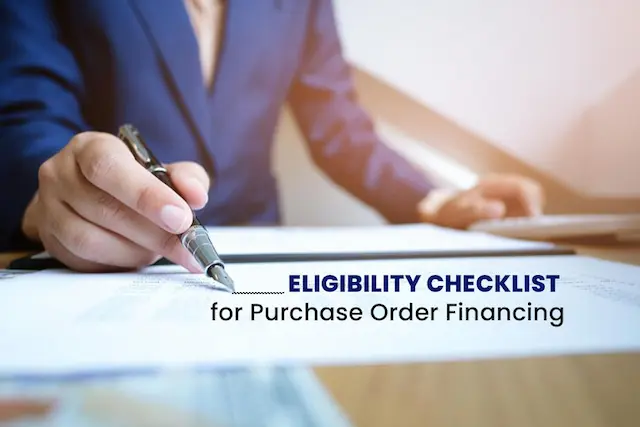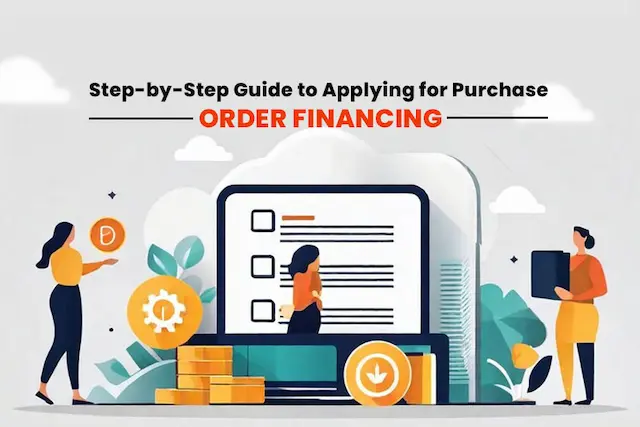Is cash strain the reason for the bottlenecked growth of your business? Learn what purchase order financing is and how it can accelerate your business’s growth in this article.
Imagine what the situation would be like for a company if it landed its dream order but failed to complete it because of a lack of funds. Unfortunate, right?
In fact, many small businesses have to go through such situations almost every month, and small businesses getting big orders is a major confidence boost. Despite the presence of multiple orders, only a few companies possess the necessary funds to meet the demand.
Declining any order is the last thing a business would want to do. Therefore, to deal with the liquidity crunch, turn to purchase order financing solutions.
What is Purchase Order Financing?
Purchase order financing, also known as PO financing, is a short-term commercial financing option that provides funds to businesses against confirmed purchase orders. Purchase order financing enables businesses to accept large orders without having to decline them due to cash flow challenges. Small and medium-sized businesses that lack sufficient cash flow or credit history to secure traditional financing options find this type of financing particularly helpful.
Furthermore, as there’s no long-term binder involved, businesses have the advantage of stopping using it at any time in case they get fewer orders.
How Does Purchase Order Financing Work
Businesses with huge potential for growth that are somehow cash-trapped because they are startups or for other reasons come to purchase order financing’s rescue. Here’s how it works:
A purchase order is issued by the prospective buyer to place an order.
After a confirmed order, the seller starts to prepare the estimated cost.
If there’s a working capital gap, the seller can opt for purchase order financing.
The PO financing lending platform provides funds to the seller.
Once the seller gets the fund, they fulfill their order.
After the order is shipped, the seller issues the invoice.
On the agreed-upon date, the borrower pays the invoiced amount to the lender.
The lender now pays the seller after deducting the fee of financing.
What are the sources for obtaining Purchase Order Financing?
Certain online financing companies provide purchase order financing, including those that offer business loans exclusively. There are some banks and traditional lenders too that can provide purchase order financing, but only to eligible businesses.
Why Do Companies Use Purchase Order Financing?
There are multiple reasons why a company uses purchase order financing. Let’s have a look at the major three here:
1. Increase Customer Base
For small businesses, adding to their customer base is vital for growth and profitability. Purchase order financing allows such firms to add to their customer base by enabling them to fulfill new orders with financial strength, even from beyond the borders.
2. Tight Cash Flow
According to one study, 61% of small firms are concerned about cash flow issues every month. Purchase order financing is a non-complex, quick, and easy way to ease cash strain in their business. They can now focus more on their growth rather than worrying about funds.
3. Seasonal Demand Spike
If a business experiences a spike in demand in a particular season of the year, the availability of funds could bottleneck their growth. Purchase order financing turns out to be a rescue at this time, as it provides funds to businesses in a short period of time.
4 Ease and Flexibility
Unlike traditional bank loans, PO financing doesn’t require collateral. This means companies can use their POs as collateral and access funds quickly without putting their assets at risk.
Which Businesses are Best Suited for Purchase Order Financing?
There are multiple companies who benefit from purchase order financing. Listing the major ones below:
Distributors
Outsourcers
Resellers
Retailers
Wholesalers
Businesses with heavy seasonal demand spike
Advantages of Purchase Order Financing
PO financing is an efficient way to fund orders when a business doesn’t have enough cash in hand to pay the supplier upfront. It further leads to growth in your business when you fulfill larger orders. Some benefits of purchase order financing include:
1. Easy To Get
Customers’ financial creditworthiness is a strong base for financial companies’ fund approval. You get fast funds simply based on your credit profile. Easy? Isn’t it! It makes it easy for startup companies to secure funds to complete their early business orders.
2. Timely Funding
PO financing companies provide timely funding to buy materials urgently. It keeps both supply chain and supplier operations active even during times of working capital shortages.
3. Better Supplier Relationships
Purchase order financing leads to a better supplier relationship as it allows you to pay on time. It can further benefit you in the long run in the form of early payment discounts and good future terms.
4. No Need for Collateral
Purchase order financing is a type of unsecured financing, which means that businesses do not need to provide collateral to secure the loan. This can be especially beneficial for businesses that do not have assets to use as collateral.
5. Better Substitute to Traditional Loans
Purchase order financing is similar to invoice financing in nature and doesn’t require monthly payments as is the case with traditional business loans.
6. No Ownership Dilution
Unlike equity financing, PO Discounting does not require businesses to give up any ownership or control over their company.
7. Improved Credit Rating
By using PO Discounting to fulfill orders, businesses can establish a track record of timely payments, which can help improve their credit rating and make it easier to obtain financing in the future.
Disadvantages of Purchase Order Financing
With advantages as a effective supply chain management method, there are certain disadvantages of purchase order financing too that you must keep in the back of your mind:
1. Cost
Purchase order financing can be costly, with rates ranging from 1% to 6% of the supplier’s costs, which results in APRs of approximately 20% to 50%.
2. Limited Funds
Unlike traditional business loans, purchase order financing is typically limited to the amount needed to fulfill a specific purchase order. This means that the lender will only provide funding to cover the costs associated with the purchase order, such as the cost of raw materials, manufacturing, and shipping.
3. Associated Risk of Non-Payment
The business still has to pay to the lending platform even in the case of customers failing to pay to the business. So, some risk is involved.
Notwithstanding its disadvantages, PO financing plays a crucial role in ensuring a business’s end-to-end supply chain process and establishing a streamlined supply chain framework.
Purchase Order Financing: D/B Traditional Lenders and Alternative Funding Options
A traditional lender (like a bank or NBFC) would often be reluctant to provide small businesses with loans against purchase orders.
Only large orders might qualify for purchase order financing.
Even the major financing companies stay away from offering money to buyers with bad credit.
It can be extremely difficult for small and medium-sized businesses to access these financing options due to additional factors, such as the creditworthiness of suppliers and customers.
Traditional lenders’ PO funding process can be lengthy, complex, and may demand collateral like bonds or equity.
Other alternative funding options have easy conditions with providing such fundings. Take Credlix for example. Credlix is a popular PO financing provider in India that offers flexible financing solutions to businesses of all sizes. We offer flexible repayment terms and customized solutions to meet the specific needs of each business using advanced technology to evaluate creditworthiness and offer fast, paperless financing.
Is Purchase Order Financing Right for Your Business?
Purchase Order (PO) financing can be an attractive option for businesses that have large orders to fulfill but do not have the necessary funds or resources to meet the demand. This type of financing allows businesses to secure the necessary funds to fulfill the order by borrowing against the value of the purchase order. This means that the lender will pay the supplier directly for the goods or services, allowing the business to fulfill the order without having to pay out of pocket.
However, it’s important to carefully consider the costs and risks associated with PO financing before proceeding. The costs of PO financing can be high, with lenders charging interest rates, fees, and other charges. Additionally, if the business is unable to fulfill the order, the lender may require repayment of the funds borrowed, which can lead to financial difficulties for the business.
Therefore, before opting for PO financing, it’s important to do your due diligence and work with a reputable lender. This involves carefully reviewing the terms and conditions of the financing, assessing the lender’s reputation and track record, and understanding the potential costs and risks involved. By taking these steps, businesses can make informed decisions about whether PO financing is the right option for them and can avoid potential pitfalls down the road.
Final Words
In conclusion, purchase order financing can be a double-edged sword for businesses. On the one hand, it offers a way to obtain funding without taking on debt or sacrificing equity. On the other hand, it can be an expensive form of financing, and not all businesses are eligible.
Before pursuing, it is important to carefully consider purchase order financing pros and cons, and to understand the terms and conditions of any financing agreement. While it can be a valuable tool for businesses seeking to fulfill large orders, it is not a one-size-fits-all solution.
With proper research and planning, purchase order financing can be an effective way for businesses to grow and succeed.
We Can Help!
Receive quick and easy advances against approved purchase orders through Credlix, the most trusted purchase order financing platform. We understand the significance of purchasing raw materials on time and at the appropriate price. Credlix PO financing enables you to obtain working cash in exchange for verified purchase orders. Get up to 40% of order value financed!
FAQs
1. How does purchase order financing work?
Assume that a company gets a big order, but it does not have funds to pay the supplier upfront. In that case, the company can benefit from PO financing by securing funds from a lender against a confirmed purchase order.
2. Is It necessary to provide a purchase order?
Yes. A purchase order works like a commercial document that verifies that an order has been placed by the buyer with a seller. It is advisable for vendors to avoid delivering or shipping products prior to the issuance of the purchase order.
3. Who can cancel a purchase order?
As long as no goods have been received based on the purchase order and the vendor agrees to the cancellation, the customer is permitted to cancel the purchase order.
4. What are the rates of purchase order financing?
The financing rate of purchase orders differs from transaction to transaction and is usually between 1.8% to 6% per month. The interest rates are determined by various factors, including the size of the order, repayment time, creditworthiness of the supplier and customer, and the supplier’s amount.
5. What is the difference between a purchase order and an invoice?
A purchase order is generated by a customer at the time when the order is placed. An invoice, on the other hand, is generated when the order is completed. Purchase order is basically a sales contract, and an invoice is sale’s confirmation.





